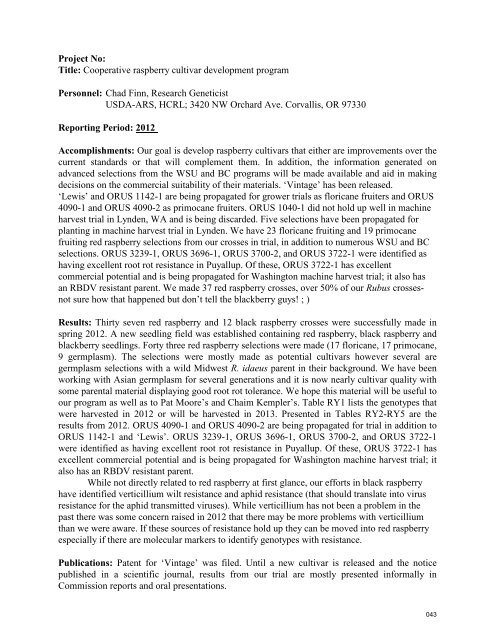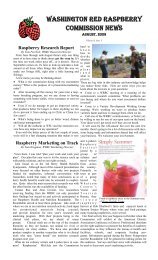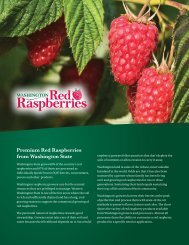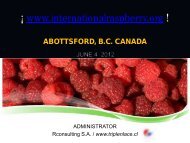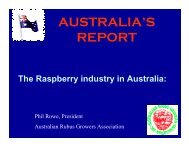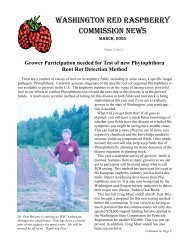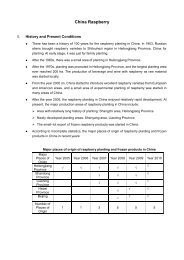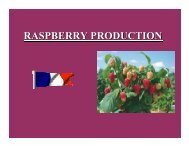2012 - Washington Red Raspberry Commission
2012 - Washington Red Raspberry Commission
2012 - Washington Red Raspberry Commission
Create successful ePaper yourself
Turn your PDF publications into a flip-book with our unique Google optimized e-Paper software.
Project No:<br />
Title: Cooperative raspberry cultivar development program<br />
Personnel: Chad Finn, Research Geneticist<br />
USDA-ARS, HCRL; 3420 NW Orchard Ave. Corvallis, OR 97330<br />
Reporting Period: <strong>2012</strong><br />
Accomplishments: Our goal is develop raspberry cultivars that either are improvements over the<br />
current standards or that will complement them. In addition, the information generated on<br />
advanced selections from the WSU and BC programs will be made available and aid in making<br />
decisions on the commercial suitability of their materials. ‘Vintage’ has been released.<br />
‘Lewis’ and ORUS 1142-1 are being propagated for grower trials as floricane fruiters and ORUS<br />
4090-1 and ORUS 4090-2 as primocane fruiters. ORUS 1040-1 did not hold up well in machine<br />
harvest trial in Lynden, WA and is being discarded. Five selections have been propagated for<br />
planting in machine harvest trial in Lynden. We have 23 floricane fruiting and 19 primocane<br />
fruiting red raspberry selections from our crosses in trial, in addition to numerous WSU and BC<br />
selections. ORUS 3239-1, ORUS 3696-1, ORUS 3700-2, and ORUS 3722-1 were identified as<br />
having excellent root rot resistance in Puyallup. Of these, ORUS 3722-1 has excellent<br />
commercial potential and is being propagated for <strong>Washington</strong> machine harvest trial; it also has<br />
an RBDV resistant parent. We made 37 red raspberry crosses, over 50% of our Rubus crossesnot<br />
sure how that happened but don’t tell the blackberry guys! ; )<br />
Results: Thirty seven red raspberry and 12 black raspberry crosses were successfully made in<br />
spring <strong>2012</strong>. A new seedling field was established containing red raspberry, black raspberry and<br />
blackberry seedlings. Forty three red raspberry selections were made (17 floricane, 17 primocane,<br />
9 germplasm). The selections were mostly made as potential cultivars however several are<br />
germplasm selections with a wild Midwest R. idaeus parent in their background. We have been<br />
working with Asian germplasm for several generations and it is now nearly cultivar quality with<br />
some parental material displaying good root rot tolerance. We hope this material will be useful to<br />
our program as well as to Pat Moore’s and Chaim Kempler’s. Table RY1 lists the genotypes that<br />
were harvested in <strong>2012</strong> or will be harvested in 2013. Presented in Tables RY2-RY5 are the<br />
results from <strong>2012</strong>. ORUS 4090-1 and ORUS 4090-2 are being propagated for trial in addition to<br />
ORUS 1142-1 and ‘Lewis’. ORUS 3239-1, ORUS 3696-1, ORUS 3700-2, and ORUS 3722-1<br />
were identified as having excellent root rot resistance in Puyallup. Of these, ORUS 3722-1 has<br />
excellent commercial potential and is being propagated for <strong>Washington</strong> machine harvest trial; it<br />
also has an RBDV resistant parent.<br />
While not directly related to red raspberry at first glance, our efforts in black raspberry<br />
have identified verticillium wilt resistance and aphid resistance (that should translate into virus<br />
resistance for the aphid transmitted viruses). While verticillium has not been a problem in the<br />
past there was some concern raised in <strong>2012</strong> that there may be more problems with verticillium<br />
than we were aware. If these sources of resistance hold up they can be moved into red raspberry<br />
especially if there are molecular markers to identify genotypes with resistance.<br />
Publications: Patent for ‘Vintage’ was filed. Until a new cultivar is released and the notice<br />
published in a scientific journal, results from our trial are mostly presented informally in<br />
<strong>Commission</strong> reports and oral presentations.<br />
043


